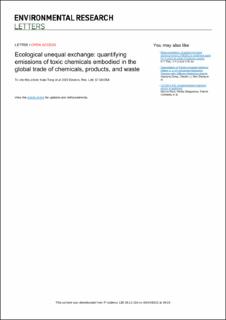| dc.contributor.author | Tong, Kate | |
| dc.contributor.author | Li, Li | |
| dc.contributor.author | Breivik, Knut | |
| dc.contributor.author | Wania, Frank | |
| dc.date.accessioned | 2022-04-26T07:55:05Z | |
| dc.date.available | 2022-04-26T07:55:05Z | |
| dc.date.created | 2022-04-04T10:16:30Z | |
| dc.date.issued | 2022 | |
| dc.identifier.citation | Environmental Research Letters. 2022, 17, 044054. | en_US |
| dc.identifier.issn | 1748-9326 | |
| dc.identifier.uri | https://hdl.handle.net/11250/2992700 | |
| dc.description.abstract | Ecologically unequal exchange arises if more developed economies ('core') shift the environmental burden of their consumption and capital accumulation to less developed economies ('periphery'/'semi-core'). Here we demonstrate that human populations in core regions can benefit from the use of products containing toxic chemicals while transferring to the periphery the risk of human and ecological exposure to emissions associated with manufacturing and waste disposal. We use a global scale substance flow analysis approach to quantify the emissions of polybrominated diphenyl ethers (PBDEs), a group of flame retardants added to consumer products, that are embodied in the trade of chemicals, products and wastes between seven world regions over the 2000–2020 time period. We find that core regions have off-loaded PBDE emissions, mostly associated with the disposal of electrical and electronic waste (e-waste), to semi-core and peripheral regions in mainland China and the Global South. In core regions this results in small emissions that mostly occur during the product use phase, whereas in peripheral regions emissions are much higher and dominated by end of life disposal. The transfer of toxic chemical emissions between core and periphery can be quantified and should be accounted for when appraising the costs and benefits of global trade relationships. | en_US |
| dc.language.iso | eng | en_US |
| dc.rights | Navngivelse 4.0 Internasjonal | * |
| dc.rights.uri | http://creativecommons.org/licenses/by/4.0/deed.no | * |
| dc.title | Ecological unequal exchange: quantifying emissions of toxic chemicals embodied in the global trade of chemicals, products, and waste | en_US |
| dc.type | Peer reviewed | en_US |
| dc.type | Journal article | en_US |
| dc.description.version | publishedVersion | en_US |
| dc.rights.holder | © 2022 The Author(s). Published by IOP Publishing Ltd. | en_US |
| dc.source.volume | 17 | en_US |
| dc.source.journal | Environmental Research Letters | en_US |
| dc.identifier.doi | 10.1088/1748-9326/ac5f95 | |
| dc.identifier.cristin | 2015027 | |
| dc.relation.project | Norges forskningsråd: 311503 | en_US |
| dc.source.articlenumber | 044054 | en_US |
| cristin.ispublished | true | |
| cristin.fulltext | original | |
| cristin.qualitycode | 2 | |

